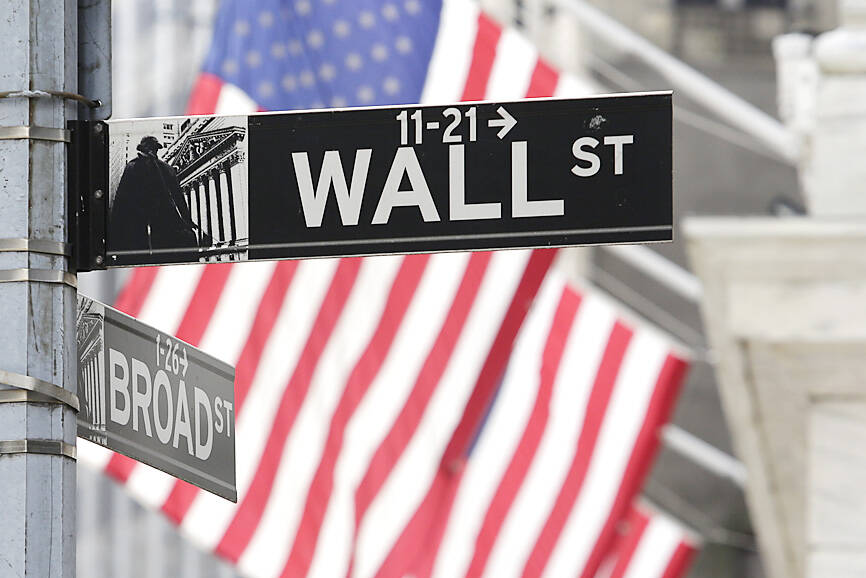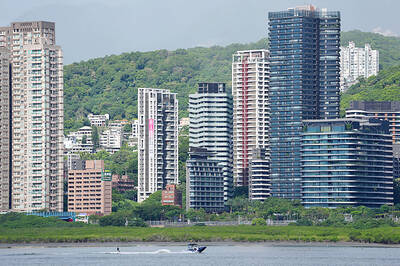The US remained the largest debtor nation of banks in Taiwan for the 37th consecutive quarter at the end of the third quarter, the central bank said on Friday last week.
Taiwanese banks’ exposure to the US stood at US$181.99 billion at the end of September, up US$6.67 billion, or 3.80 percent, from a quarter earlier, it said.
The increase came as banks in Taiwan continued to raise investments in trusted assets and increased interbank loans and financial bond purchases in the US market amid a stable US economy, Department of Financial Inspection Deputy Director-General Hsieh Jen-chun (謝人俊) said.

Photo: AP
The US accounted for 29.81 percent of Taiwanese banks’ total international claims at the end of September, compared with a new high of 29.89 percent at the end of June, Hsieh said.
China remained the second-largest debtor nation of Taiwan’s banking sector with exposure at US$48.27 billion as of the end of September, up 4.34 percent from the end of June, which Hsieh attributed to the yuan’s appreciation against the US dollar and an increase of loans and bond purchases.
Still, the gap in exposure to the US and China widened to US$133.7 billion at the end of September from US$129.0 billion at the end of June, as the Chinese economy was hit by escalating trade tensions between Washington and Beijing, growing geopolitical unease and rising protectionism, the central bank said.
After the US and China, Luxembourg took the third spot with exposure from Taiwanese banks at US$44.62 billion, up 9.68 percent from a quarter earlier due to an increase in investments in currency mutual funds, ahead of Australia (US$40.19 billion, up 7.39 percent) and Japan (US$35.51 billion, down 17.04 percent).
Rounding out the top 10 debtor areas were Hong Kong with exposure of about US$32.20 billion, down 3.54 percent on a weaker economy, followed by the UK (US$20.56 billion, up 1.52 percent), Singapore (US$17.78 billion, down 2.28 percent), South Korea (US$17.26 billion, up 7.17 percent) and France (US$15.98 billion, down 0.34 percent).
Overall, international claims by Taiwanese banks stood at US$610.4 billion at the end of the third quarter, up 4.08 percent from a quarter earlier, as the local banking sector increased lending to the nonbanking segment in the private sectors of debtor nations, the central bank said.
Exposure to the top 10 debtors totaled US$454.3 billion, accounting for 74.43 percent of the total international claims of Taiwan’s banks, it said.

RECYCLE: Taiwan would aid manufacturers in refining rare earths from discarded appliances, which would fit the nation’s circular economy goals, minister Kung said Taiwan would work with the US and Japan on a proposed cooperation initiative in response to Beijing’s newly announced rare earth export curbs, Minister of Economic Affairs Kung Ming-hsin (龔明鑫) said yesterday. China last week announced new restrictions requiring companies to obtain export licenses if their products contain more than 0.1 percent of Chinese-origin rare earths by value. US Secretary of the Treasury Scott Bessent on Wednesday responded by saying that Beijing was “unreliable” in its rare earths exports, adding that the US would “neither be commanded, nor controlled” by China, several media outlets reported. Japanese Minister of Finance Katsunobu Kato yesterday also

Taiwan’s rapidly aging population is fueling a sharp increase in homes occupied solely by elderly people, a trend that is reshaping the nation’s housing market and social fabric, real-estate brokers said yesterday. About 850,000 residences were occupied by elderly people in the first quarter, including 655,000 that housed only one resident, the Ministry of the Interior said. The figures have nearly doubled from a decade earlier, Great Home Realty Co (大家房屋) said, as people aged 65 and older now make up 20.8 percent of the population. “The so-called silver tsunami represents more than just a demographic shift — it could fundamentally redefine the

China Airlines Ltd (CAL, 中華航空) said it expects peak season effects in the fourth quarter to continue to boost demand for passenger flights and cargo services, after reporting its second-highest-ever September sales on Monday. The carrier said it posted NT$15.88 billion (US$517 million) in consolidated sales last month, trailing only September last year’s NT$16.01 billion. Last month, CAL generated NT$8.77 billion from its passenger flights and NT$5.37 billion from cargo services, it said. In the first nine months of this year, the carrier posted NT$154.93 billion in cumulative sales, up 2.62 percent from a year earlier, marking the second-highest level for the January-September

‘DRAMATIC AND POSITIVE’: AI growth would be better than it previously forecast and would stay robust even if the Chinese market became inaccessible for customers, it said Taiwan Semiconductor Manufacturing Co (TSMC, 台積電) yesterday raised its full-year revenue growth outlook after posting record profit for last quarter, despite growing market concern about an artificial intelligence (AI) bubble. The company said it expects revenue to expand about 35 percent year-on-year, driven mainly by faster-than-expected demand for leading-edge chips for AI applications. The world’s biggest contract chipmaker in July projected that revenue this year would expand about 30 percent in US dollar terms. The company also slightly hiked its capital expenditure for this year to US$40 billion to US$42 billion, compared with US$38 billion to US$42 billion it set previously. “AI demand actually